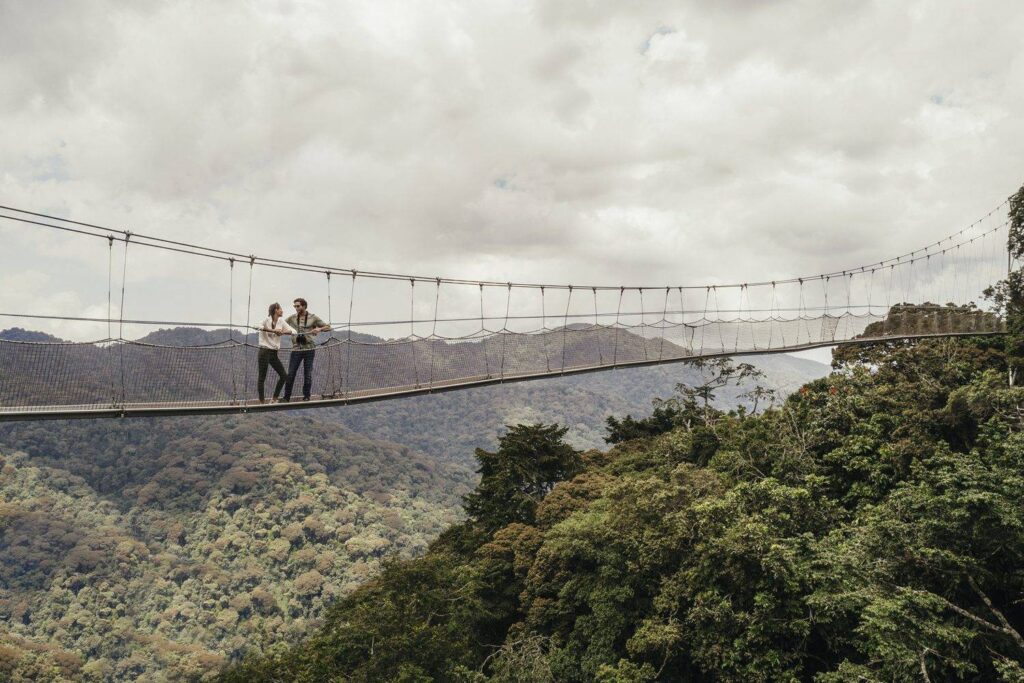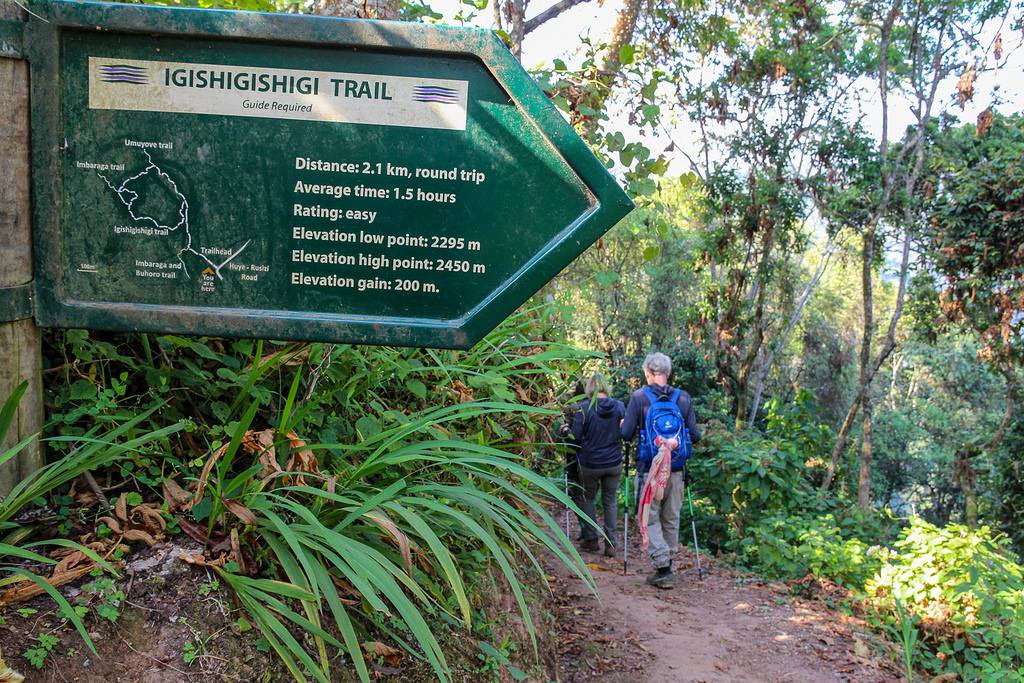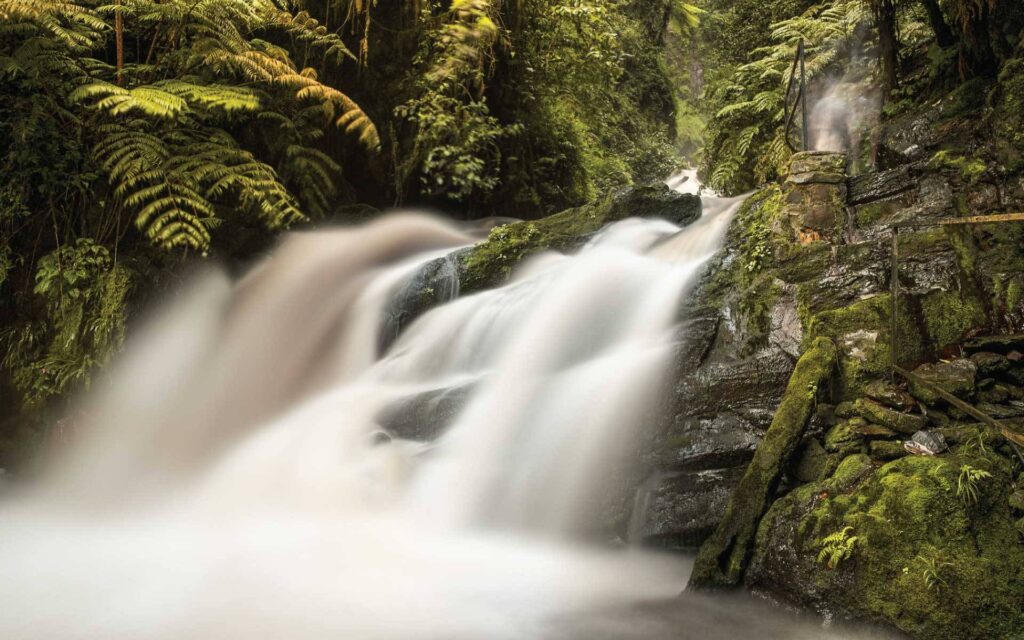Canopy Walk
Canopy Walk: Canopy walks are a unique activity that are only found in Rwanda‘s Nyungwe National Park in East Africa. They are fascinating and will captivate you. A park with a great biodiversity of over 1000 plant species, 120 kinds of butterflies, 85 species of animals, and a range of activities that may include birding, chimpanzee trekking, camping, hiking, research, and many more, with the goal of guaranteeing tourist happiness.

Along with other tourist-related activities like chimpanzee tracking, birdwatching, trekking, camping, and many more, the activity was developed to increase tourism in the park. The plan to establish the walkway was proposed in 2008, and with U.S.A.I.D.’s help, development on the walkway began in 2010 under the auspices of the non-governmental organization Green Heart. The Rwanda Development Board’s Chief Operating Officer, Claire Akamanzi, and Trade and Industry Minister Monique Nsazabaganwa inaugurated the canopy walkway in 2017.
The three portions that make up the canopy walk are each different lengths: the shortest is 25 meters, the longest is 90 meters, and the middle stretch is 45 meters. Regardless of where a visitor is on the canopy walk, the view is always pleasing and lovely.
Since its debut in 2017, the canopy walkway—which is the only one in the East African region—has improved and expanded tourism in both Nyungwe National Park and Rwanda overall, drawing more visitors who come to enjoy the unique experience.
Many people have looked up how to enter Nyungwe National Park in order to participate in the activity due to the rise in tourist arrivals.
How to take part in the trek across the canopy.
There’s only one location in East Africa where travelers can take part in the Canopy Walk: Nyungwe National Park. Visitors can get to the park by plane or by road. The National Park is roughly 190 kilometers from the capital city of Kigali, and assuming the automobile is in good condition, it should take them 5 hours to go there by road.
The national airline, Rwanda air, provides internal flights for travelers who can afford to travel by air. Travelers can arrange a flight from Kigali to Kamembe town, which is located near the park. From Kamembe town, they can take a car trip to cover the remaining 49.5 kilometers to reach Nyungwe National Park. Compared to using air or road transportation, traveling to the park takes around an hour and ten minutes, making it quick and simple.
When entering the national park, visitors should first pass through the Uwinka Reception Center, which is accessible by the Gisakura or Katabi gates to the west and east, respectively. The traveler must pay a fee of sixty dollars USD at each entry in order to participate in the canopy walk.
The tourists who are intending to take part in the activity are given instructions at the reception regarding what to bring, how to use the equipment, and other details. They are also introduced to a guide who will lead them to the Igishigishigi route.

The Igishigishigi Path
The Igishigishigi route was selected for the canopy walkway out of all the trails due to its simplicity and ability to get to the walkway in the least amount of time. The Igishigishigi route was deemed to be the most suitable option amongst the trails, and as such, the walkway’s halfway point was chosen. The Uwinka Visitors Center is where the 2.1-kilometer trail begins. As you continue down the trail, you’ll observe a variety of trees and plant types as well as the Uwinka ridge. Along the journey, the canopy walkway is found by visitors as they proceed. Before arriving at the Canopy Walkway, visitors can observe lichens, mosses, orchids, ferns, and other plant species along the walk.
But there are other equally significant paths in Nyungwe National Park, such as:
The Ngabwe Trail is primarily used by hikers whose goal is to reach the highest peaks, but nature enthusiasts who want to witness wildlife also frequently visit the trail. The trail leads to the Ngabwe Mountain. In addition, the route allows visitors to have picnics at designated areas. These amenities allow visitors to get up close and personal with primates like chimpanzees and monkeys like mangabeys.
Bigugu Trail: This trail leads to Mountain Bigugu, which is typically chosen by visitors who would like to engage in hiking. Travelers can trek to the peak’s highest point and engage in outdoor activities like birdwatching, as the area is home to a variety of bird species, including the Red Collared Mountain Babbler. At the highest point, one may also enjoy views of the stunning Lake Kivu and a variety of plant species, such as crimson flowers, red hot poker, and more.

Isumo waterfall hike: The trail goes to the stunning waterfalls, but en route you’ll witness deep jungles and dense flora. The trail is also slick, although the waterfalls provide refreshing breezes. Hiking the trail is like taking a stroll through paradise because of all the different bird species, butterflies, and monkeys that can be spotted.
The Karamba Birding Trail is notable for its comparatively flat terrain, which allows birders to observe common birds like the Turaco. Nevertheless, because of the area’s flatness, other activities like camping and picnicking are also possible, and primates like blue monkeys can be spotted.
The Kamiranzovu Marsh Trail leads to the Kamiranzovu Swamp, which is frequented by birds such as the Graurer Rush warbler and is visited by a variety of animal species during the dry season. Additional trails could be the Nile Trail’s source, which is important for a variety of bird species, the Umoyove Trail, which is important for mahogany tree species but also chimpanzee viewing in the area, the Rukuzi Trail, which is important for primates like chimpanzees, and the Irebero Trail, which offers visitors a peak view of Lake Kivu. The Imbaraga trail is important because it can lead visitors to waterfalls and offers the chance to see chimpanzees. The Umbugote route offers a view of the Burundi mountains and a variety of plant species.
Congo Nile Divide Trail is a favorite among hikers because it is the longest and offers a variety of plant species to be observed when trekking and camping. The river Rukarara is thought to be the source of the Nile, which is the source of the Nile Trail.
When the Canopy Walk Begins
Travelers can engage in various activities because the canopy walk is a year-round activity that is conducted every day. Though it is open daily, there are specific times during the day that the canopy walk is conducted. These are in the morning at 8:00 or 10:00 am, in the afternoon at 3:00 pm, and at night at 7:00 pm.
At the pathway covered by canopies
Many animal, bird, and butterfly species as well as types of vegetative cover are seen throughout Nyungwe National Park at various points along the canopy walk trail. Primates, such as the many monkey species—such as the owl-faced, blue, red-tailed, white, and Angola colobuses—as well as other animal species, such as golden cats, duikers, giraffes, lions, buffalos, and chimpanzees—jump from tree to tree. Graphium gudunesi, metisella articolla, zenonia crasta, and charaxes mafuga are just a few examples of the butterfly species that provide visitors participating in the canopy walk with an amazing experience.
Other sites that are visible from the canopy walkway include Lake Kivu, the dense greenery, and 200 different types of trees. It is clear that hardwood trees make up the majority of the upper canopy, as seen from the various plant species and during canopy walks.
Things to Think About While Walking the Canopy
As the canopy walk requires exerting one’s physical power, it is essential that participants be clear of any health issues that could impair them when hiking to the canopy. It is recommended that those with health issues such as heart problems or lung problems that can lead to dyspnea abstain from the sport.
Since the activity is performed many meters above the ground, it is not recommended for those who have acrophobia or a fear of heights. To prevent accidents while on the Canopy Walkway, participants are urged to heed the tour guides’ directions, as they are highly qualified professionals.
Carrying gear for the Canopy Walk
It is recommended that travelers pack a variety of products for their trip, such as
Food, for example, is necessary for the young children who cannot go for very long without it in order to prevent problems when traveling.
cameras that can assist in documenting the lovely moments spent at the canopy walkway.
Raincoats are recommended because the area is forested and receives 2000 mm of precipitation annually. Since rain is a common occurrence, it is advisable to pack a jacket in order to be prepared.
Hiking boots because the path is muddy and slick. It is recommended to bring your own boots, but if you don’t have any, hiking boots can be rented at the reception desk.
Additionally, free hiking sticks are available at the front desk. These can be used in challenging hiking locations and serve as a support in steep ones.
Canopy Walk Park Fees in Nyungwe
A payment of sixty dollars USD must be made to the Uwinka reception center’s reception in order to participate in the canopy walk.
NOTE: Nyungwe National Park may provide a range of customized products. For example, following a canopy walk, visitors can track chimpanzees on several paths or go bird watching, which just takes two hours. This allows visitors to engage in additional activities, creating more memories and ultimately increasing consumer happiness.
Another requirement for anyone participating in a canopy walk is that they must be older than six years old. Children must also be accompanied by a parent or legal guardian. For the activity to be safe, a person or a group should always be accompanied on walks under the canopy by a qualified guide.
“Go to Nyungwe National Park in Rwanda and have the opportunity to participate in this incredible tour activity that will captivate you—the Canopy Walk.”



